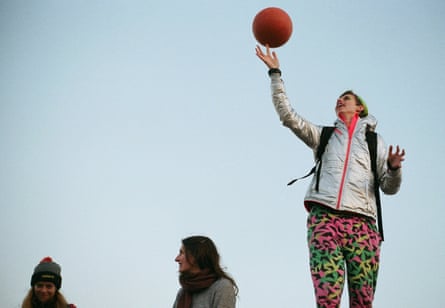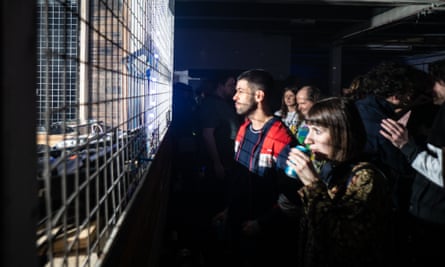It has been two years since it felt as if London’s nightlife had truly hit rock bottom. Countless clubs had closed – Plastic People, Madam Jojo’s, The End, Dance Tunnel to name a few – climaxing in summer 2016, when superclub Fabric temporarily lost its licence over drug deaths, a high-profile case that threw the survival of UK clubbing into question. For all the talk of London becoming a 24-hour city, it felt as if nightlife – particularly the kind that catered to niche subcultures, esoteric tastes or queer crowds – was being pushed out.
Last week, it hit a new low when Hackney council – an area of the city that is home to some of the capital’s richest, and most diverse independent nightlife – voted to introduce what local campaign group We Love Hackney dubbed “the toughest restrictions on nightlife in Britain”. The new plans, opposed by 73% of 680 consultation respondents, meant capping opening hours so that the latest newly licensed venues can open is midnight, and only at the weekend. This can only be extended once a venue has proven that it won’t provoke a rise in antisocial behaviour. Despite reassurances from Hackney council that it would “help and support” venues in making licence applications, the decision cements a long-held view that local authorities perceive nightlife as a problem to be contained, rather than a vital creative and emotional outlet.

As the news broke, London’s “night tsar” Amy Lamé came under fire and was questioned about the efficacy of her role, created in 2016, with the aim of turning London into a 24-hour city and generating up to £3bn from the so-called “night-time economy”. “Shoutout to our government for trying to make us the world’s first truly 12-hour city with a 24-hour tube line,” scoffed DJ and producer Midland.
Although the rest of the UK’s nightlife has also suffered – recent closures include Sankey’s in Manchester and Surrey Vaults in Bristol, closed due to gentrification and noise complaints respectively – the intensity of change in London is unparalleled.
As central London’s nightlife has increasingly been under siege, the scene is moving to the city’s periphery – legally, spiritually and geographically. The Cause, one of London’s newest nightclubs, located in a former car workshop in Tottenham, is a prime example. On a bright evening, I meet Stuart Glen, who has spent the past six months converting the warehouse into a DIY venue, and Andy Blake, co-founder of long-running club night World Unknown in Brixton and a stalwart of the city’s rave scene. “Since 2016, the whole landscape has changed,” says Blake. “We had that big forest fire that Fabric was part of, and now this year, all these green shoots are coming up.”
The view that surrounds us is one of concrete and metal; the only sign on the building reads London Tyres. But roll down a garage door and the new space unravels; a central DJ booth surrounded by a metal cage and a custom soundsystem hanging either side. This is what the green shoots look like: reimagined empty spaces. The attitude now, Glen says, “is a lot more: ‘Fuck it!’”
They have permission to use the space – which is currently awaiting redevelopment – for 18 months; if it goes well, potentially longer. Glen wants to work with the local community and has pledged to raise £25,000 for mental health charities, including Mind in Haringey. He also wants the space to be open for studios and workshops. The Cause operates in the space between squat party and conventional venue. “We’ve got roots in the history of that kind of stuff, but we’re going above board,” says Glen.

This approach is becoming a familiar pattern in the capital. Just next door to The Cause is Grow Tottenham, a community garden, cafe and club in a previously disused warehouse. “I think more people have a desire to save their spaces, build on them and create clubs that you can actually breathe in,” says Sadie Haque, who works as a DJ and set designer and has been working with volunteers to create the space from scratch. “It means more opportunities for people to evolve and have real conversations, which isn’t always easy on a dark dancefloor.”
For Blake, this approach demonstrates how the clubbing community can transform a city. “This is so much more like the socialist-based groups you see running clubs in Berlin,” says Blake. “So many of them were squatted, run on a people-first mentality. Obviously you need to make money to pay people, pay for things to get fixed and make them safe, but the money’s not first – the main thing is community and people.”
Perhaps building out of the same youth-driven social and political momentum that has fuelled a rise in inclusive club nights across the UK that focus on creating a home or platform for specific minority identities – such as Siren, BBZ, Uniti and Pussy Palace in London, Come Thru in Leeds, Peach, Fuse and Tomboy in Glasgow, Meat Free in Manchester and Thorny in Bristol – a growing number of event promoters in London are turning away from mainstream clubs, instead seeking out informal venues where they can host events without compromising on creating safe spaces for respectful, committed crowds. The London DIY parties are promoted like illegal raves, using secret addresses and informal spaces in the fringe boroughs of Manor House, Tottenham and Walthamstow.
Natalia Szczepanczyk co-founded Universe of Tang with five friends in 2016, promoting by word of mouth for “more of a community feel”. Using warehouse spaces gives the crew “complete freedom to be completely in charge of what we do”. They spend two days transforming a space into a “multi-sensory” party environment. “On top of custom-made sculptures and visuals, we also incorporate an aroma into each party. For example, hanging lemons, along with sandpaper to rub the peel, or fresh herbs on the DJ booth so people can explore the smells,” says Szczepanczyk.

These parties are driven by a desire for “greater freedom on the dancefloor”. In other words; a safe yet permissive atmosphere, limitless opening hours and hands-off security. Most of the people I interviewed were critical of security in mainstream clubs. “They’re like someone with a lightsabre constantly running through the club, saying: ‘Don’t do that, don’t do this,’” said one promoter. “It just fuels aggression.”
For Lewis G Burton, a DJ and promoter who runs queer performance night Inferno, the move to the fringes has been inspired by travelling around Europe, clubbing in cities such as Berlin, Paris or Amsterdam and seeing how “free and open-minded the venues and parties are there … whereas in London we’ve been sold out; some yuppies will move near a venue and complain about the noise”, he says.
“Thankfully, that has just been sorted,” he adds, acknowledging the government’s support for the “agent of change” principle that would place responsibility on property developers to take into account venues that exist in the vicinity and manage any noise themselves. “Albeit a little too late.”
In theory, London’s nightlife should feel better guarded now than ever before. As well as the agent-of-change principle, mayor Sadiq Khan has a “24-hour” vision for the city, and the night tube has allowed the suburbs to become more viable clubbing destinations (The Cause, right by Tottenham Hale tube station, joins a growing number of venues in the area, including Five Miles and Styx). Lamé’s appointment was also designed to put confidence back into the city’s nightlife. I spoke to her in May to discuss the capital’s DIY activity, but she declined an interview last week following the news of Hackney Council’s recent licensing plans.

In May, Lamé acknowledged that more can always be done to support independent venues, but offered a blunt response as to whether she believes a more hands-off approach – as seen in cities such as Berlin – could benefit independent venues in London that struggle to meet licensing and regulations: “I’d say if you can’t conform to licensing or police regulations, you shouldn’t be running a venue. There are always one-offs that are happening in spaces that do have licences, that are regulated, have safety certificates and that’s really important. But if you’re asking me if illegal raves are a good idea, I’d say absolutely not.”
Still, London illegally raves on. In March, it was reported that unlicensed music events had doubled in London between 2016–2017, linking the rise to a decline in traditional clubs. World Unknown’s Andy Blake rubbishes the story. “People have been putting on these kinds of parties for ever.” Anecdotally, the rave scene does appear to be in good health, representing the most uncompromising expression of what a growing crowd has been trying to create in London: total, unrestrained freedom to come together and dance.
On a bank holiday weekend, the sun blasts down on a patch of forest in an otherwise urban corner of the city. Despite the weather, black clothing is ubiquitous among the troupes of young people decked in health-goth clubwear. They wander across a field towards the techno pulsing from the trees, the Olympic Park’s Orbit tower jutting from the horizon behind them.
It’s a sunshine edition of an underground techno party (which I promised to keep anonymous) founded three years ago in an east-London basement. At least 100 people are gathered, sprawled beneath a tree in various states of undress, while the dancefloor – contained by bushes and sheltered by a camouflage net – is in constant motion, boots kicking dust into the hot air. Depending on who you ask, it’s either the start, middle or end of a weekend of non-stop partying. The music has been running since sunrise. “I think some people have been here a while …” says one person as they pass around a bottle of prosecco and rub sun cream into the gaps left between chest harnesses.

Over the years, the party has taken place in a variety of spaces indoors and out, keeping a tight hold on who attends. Its organisers describe their “activist approach” and dislike the term “rave”; they prefer “community project”. The wellbeing of partiers is also crucial. “We take care of people,” they say, telling me they take fire safety very seriously and have a trained nurse in attendance: “We don’t just let people go wild in a space.”
The organisers are committed to creating common ground for people across the queer and straight clubbing community, while challenging the assumption that top-down regulation is a prerequisite to creating a safe and inclusive space. They describe their mission not as a party, but “a massive cultural challenge, to try to give people an environment where they can appreciate and teach or learn from each other what’s best for the future of what we want in the city”.
Whether operating in legal grey areas or on the periphery of central London, it’s clear the capital’s best nightlife is now to be found at the margins, in every sense.









Comments (…)
Sign in or create your Guardian account to join the discussion